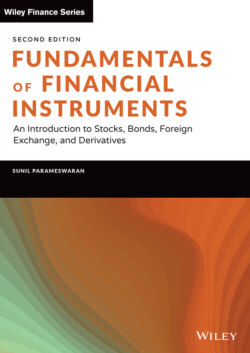Читать книгу Fundamentals of Financial Instruments - Sunil K. Parameswaran - Страница 97
EXAMPLE 2.14
ОглавлениеLet us consider the vector of cash flows shown in Table 2.3. Assume that the interest rate is 8% per annum, compounded annually. Our objective is to compute the present value and future value of the entire series.
TABLE 2.3 Vector of Cash Flows
| Year | Cash Flow |
|---|---|
| 1 | 2,500 |
| 2 | 5,000 |
| 3 | 8,000 |
| 4 | 10,000 |
| 5 | 20,000 |
The present and future value of the series is depicted in Table 2.4. As can be seen, we have simply computed the present and future value of each term in the series, and summed up the values.
TABLE 2.4 Present and Future Values of the Cash Flows
| Year | Cash Flow | Present Value | Future Value |
|---|---|---|---|
| 1 | 2,500 | 2,314.8148 | 3,401.2224 |
| 2 | 5,000 | 4,286.6941 | 6,298.5600 |
| 3 | 8,000 | 6,350.6579 | 9,331.2000 |
| 4 | 10,000 | 7,350.2985 | 10,800.0000 |
| 5 | 20,000 | 13,611.6639 | 20,0000.0000 |
| Total Value | 33,914.1293 | 49,830.9824 |
While computing the present value of each cash flow we have to discount the amount so as to obtain the value at time “0.” Thus the first year's cash flow has to be discounted for one year, whereas the fifth year's cash flow has to be discounted for five years. On the other hand, while computing the future value of a cash flow we have to find its terminal value as at the end of five years. Consequently, the cash flow arising after one year has to be compounded for four years, whereas the final cash flow, which is received at the end of five years, does not have to be compounded.
There is a relationship between the present value of the vector of cash flows as a whole and its future value. It may be stated as:
In this case
